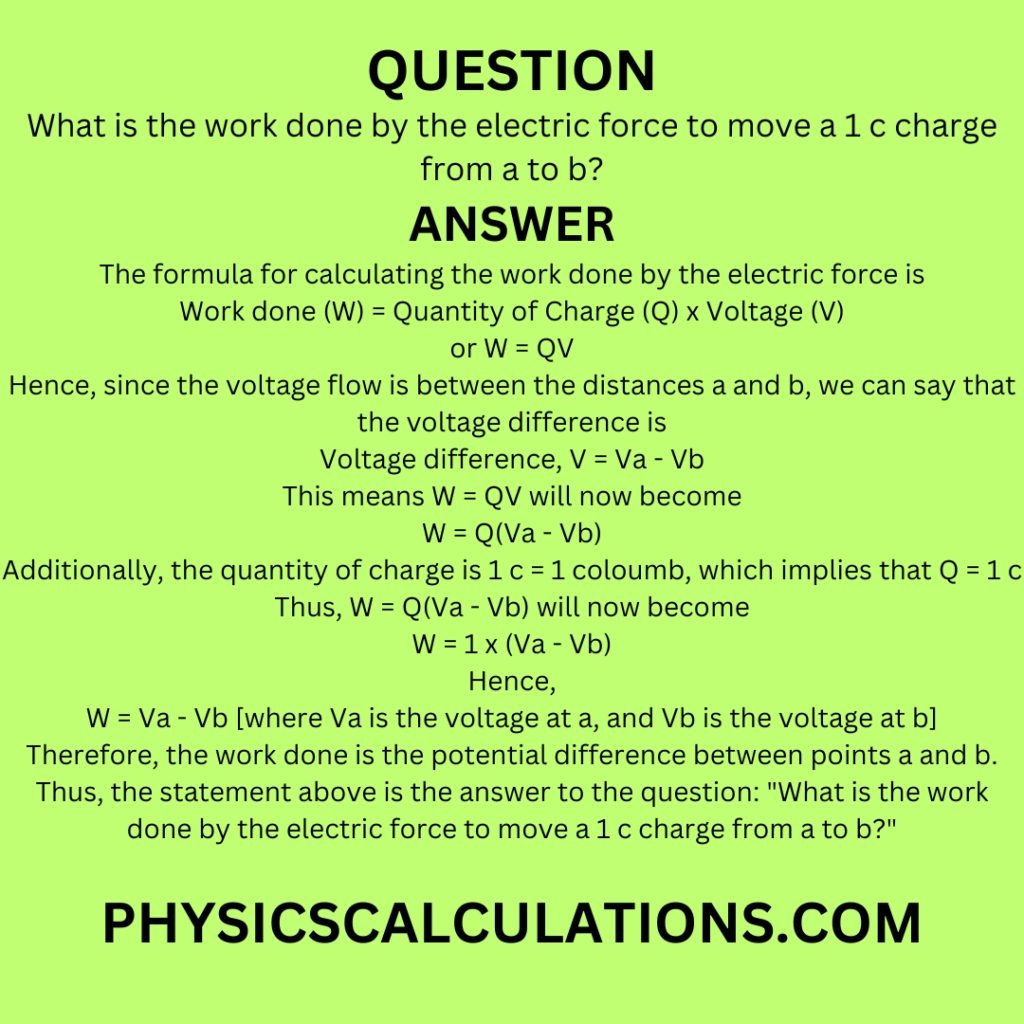Question:
What is the work done by the electric force to move a 1 c charge from a to b?

Solution
The formula for calculating the work done by the electric force is
Work done (W) = Quantity of Charge (Q) x Voltage (V)
or W = QV
Hence, since the voltage flow is between the distances a and b, we can say that the voltage difference is
Voltage difference, V = Va – Vb
This means W = QV will now become
W = Q(Va – Vb)
Additionally, the quantity of charge is 1 c = 1 coloumb, which implies that Q = 1 c
Thus, W = Q(Va – Vb) will now become
W = 1 x (Va – Vb)
Hence,
W = Va – Vb [where Va is the voltage at a, and Vb is the voltage at b]
Therefore, the work done is the potential difference between points a and b.
Thus, the statement above is the answer to the question: “What is the work done by the electric force to move a 1 c charge from a to b?”
Explanation:
When electricity flows from point A to point B, we can now say that work is being carried out (work is done). Thus, a potential difference is the quantity of work done in moving a positive charge from a lower potential to a level of higher potential.
Potential difference (voltage), V = work done in moving a charge (W) / quantity of charge (Q)
Which implies that
V = W/Q
After cross multiplying the above formula to obtain work done
W = QV
Quantity of charge is measured in coloumbs, work is in joules, while potential difference is in volts.
We can also apply the following formulae to find work done in a circuit:
- W=QV
- W=IVt [Because Q=It, and t=time]
- W=I2Rt [Because V=IR, and R=resistance in the circuit]
- W=VQ x d [V = potential difference, and d=distance]
Examples of How to Find a Work Done in a Circuit
Here are a few examples with their solutions to guide you on how to find work done in a circuit:
Example 1
A 50μC charge flows through a conductor. If the potential difference between its ends is 20mV. Find the work done by the charge.
Solution
Data
Quantity of charge, Q = 50μC = 50 x 10-6C
Potential difference, V = 20mV = 20 x 10-3V
Work done, W =?
And W = QV
Which implies that
W = 50 x 10-6 x 20 x 10-3 = 10-6 Joules or 1μJ
Example 2
A point charge of magnitude 2 x 10-6 C is moved through a distance of 0.50m against a uniform electric field intensity of 30v/m. Determine the work done on the charge.
Solution
Data
Quantity of charge, Q = 2 x 10-6 C
Electric field intensity = 30 v/m
Distance, d = 0.50 m
and the formula for electric field intensity is
E = F/Q
After cross multiplication Force, F = EQ
Work done, W = Force (F) x Distance (d)
Therefore, W = F x d = EQ x d = 30 x 2 x 10-6 x 0.5 = 3 x 10-5 Joules
Therefore, the work done is 3 x 10-5 Joules
You may also like to read:
How to Calculate the Cost of Electricity Per kWh
Also: How to Derive Period From Angular Velocity
Additionally: How to Calculate the Work Function of a Metal
Reference